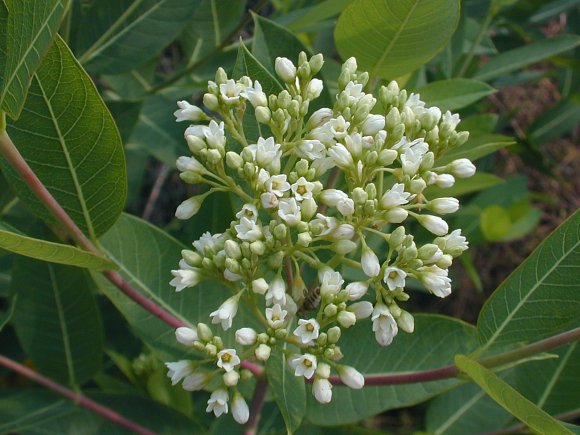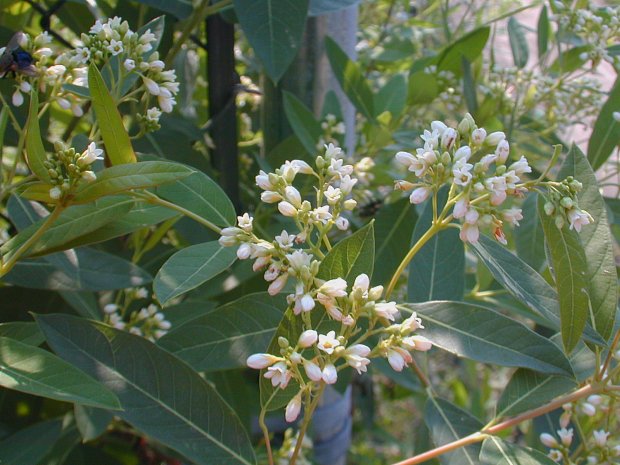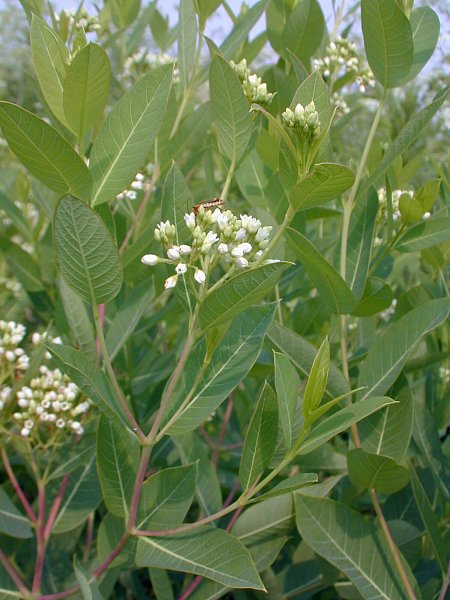Description: This herbaceous perennial plant becomes about 2½–5' tall at maturity. Initially, this plant develops an erect central stem with opposite leaves during the late spring, but during early to mid-summer it branches abundantly. The stems are light green to red, terete, glabrous, and sometimes glaucous. At intervals along these stems, there are pairs of opposite leaves. These leaves are 1½–3½" long and about one-third as much across; they are broadly elliptic to broadly elliptic-oblong in shape and smooth (entire) along their margins. The upper leaf surface is medium green or yellowish green and glabrous, while the lower leaf surface is light green, glabrous, and sometimes glaucous. Leaf venation is pinnate. When petioles are present, they are up to ¼" long, light green, and glabrous; otherwise, the leaves are sessile. Plants with sessile leaves are sometimes referred to as Apocynum sibericum. The stems and leaves contain a milky latex that is bitter-tasting and toxic. The upper stems and some lateral stems terminate in panicles of flowers spanning 1–3" across; these panicles are flat-headed to dome-shaped.

Each small
flower is about 2-3 mm. across and 3-5 mm. long, consisting of 5 white
petals, a light green calyx, 5 stamens, and a pistil. The petals are
ovate to oval in shape and they are erect to slightly spreading;
the calyx is glabrous and it has 5 triangular teeth. The branches and
pedicels of the panicles are light green or light yellowish green,
terete, and glabrous; individual pedicels are 2-6 mm. long. The
blooming period usually occurs during the summer for about 1 month. The
flowers are sweetly fragrant. Afterwards, cross-pollinated flowers are
replaced by pairs of follicles (seedpods that open along one side).
Mature follicles are 4-8" long, narrowly cylindrical in shape, and dark
brown. These follicles eventually split open to release their seeds to
the wind. Individual seeds are 4-6 mm. long, linear in shape, and
brown; they have tufts of white hair at their apices that help to carry
them aloft. The root system is long-rhizomatous, often producing clonal
colonies of plants.
Cultivation:
The preference is full sun and wet to mesic conditions. This weedy
plant adapts to mildly acidic to alkaline soil containing loam,
clay-loam, or clay-gravel. It readily tolerates flooded conditions
during the spring, while tolerating drought later in the year. By late
summer, the lower leaves of this plant turn yellow and begin to fall
off as its condition steadily deteriorates. In moist open areas,
clonal colonies can spread aggressively from underground rhizomes.

Range &
Habitat:
The native Common Dogbane occurs in every county of Illinois, where it
is quite common (see Distribution
Map).
Habitats include wet prairies, prairie swales, soggy thickets, moist
meadows along rivers, edges of swamps, seasonal wetlands in open areas,
abandoned fields, poorly drained areas along fence rows, poorly drained
areas in vacant lots, poorly drained areas in junkyards, roadside
ditches, and gravelly depressions along railroads. Common Dogbane is
usually found in degraded wetlands that have a history of
disturbance. It is a pioneer species of such habitats.
Faunal Associations:
The abundant nectar of the flowers attracts many kinds of insects,
including
cuckoo bees (Nomada spp.),
Halictid bees, plasterer bees (Colletes
spp.), masked bees (Hylaeus
spp.), Sphecid wasps, Syrphid flies, bee
flies (Bombyliidae), Tachinid flies, Calliphorid flies, butterflies,
skippers, and beetles (Robertson, 1929). These insects vary in how
effectively they
cross-pollinate the flowers. The larvae of
several moths feed on Common Dogbane, including the Delicate
Cycnia (Cycnia
tenera), Oregon Cycnia (Cycnia oregonensis),
Six-spotted Gray (Spargaloma sexpunctata),
and a Gracillariid moth (Marmara
apocynella);
see Wagner (2005), Covell (1984/2005), and Needham et al. (1928).
Larvae of the last moth bore through the stems of this plant. Other
insect feeders include larvae and adults of the Dogbane Beetle (Chrysochus auratus),
larvae of the Red Milkweed Beetle (Tetraopes
tetrophthalmus), larvae of the Dogbane Flower Midge (Clinodiplosis apocyni),
the Large
Milkweed Bug (Oncopeltus
fasciatus), and an aphid (Aphis
asclepiadis);
see Clark et al. (2004), Yanega (1996), Felt (1917), Hoffman (1996),
and Hottes & Frison (1931). Mammalian herbivores usually avoid
the consumption of Common Dogbane because the bitter
foliage contains cardiac glycosides and other toxic compounds.

Photographic
Location:
A fence row near Urbana, Illinois, and a remnant prairie along a
railroad in Savoy, Illinois.
Comments:
Another
common name
for this plant is Indian Hemp, because native Amerindians obtained
strong silky fibers from the stems. These fibers were used as twine in
basketry, mats, netting, rope,
and other artifacts. Some early French explorers remarked upon the
abundance of this plant in the original prairie, which they referred to
as 'hemp' in their writings. Common Dogbane (Apocynum cannabinum)
can
be distinguished from a similar species, Spreading Dogbane (Apocynum
androsaemifolium), by its smaller flowers with more erect
petals. The
flowers are Spreading Dogbane are about 6-8 mm. long and similarly
across;
their petals are ascending, rather than erect, and the tips of their
petals are recurved, rather than straight. Unlike Common Dogbane,
Spreading Dogbane is typically found in upland habitats where the soil
is more sandy and/or acidic.